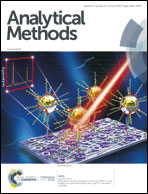Multi-element quantitative analysis of soils by laser induced breakdown spectroscopy (LIBS) coupled with univariate and multivariate regression methods†
Abstract
It is crucial to make comprehensive assessments of soil under economic and efficiency requirements in order to guide the rational use of soil resources, including the identification of attributes, the control of pollutants, and the management of nutrients. Laser induced breakdown spectroscopy (LIBS) is excellent for such applications due to its unique advantages of simple preparation, rapid measurement, and multiple-element analysis. An analysis of Si, Al, Mg, Ca, Na, K, Mn, Ba, Ti, Cr, Cu, Sr and P in different standard soils using LIBS is reported here for the comparison of the quantitative results of a univariate regression method (calibration curve) and two multivariate regression methods (partial least squares regression (PLSR) and support vector regression (SVR)). As a result, the correlation coefficients (R2) of the Ca, K, Mg, Na and Sr elements were all greater than 0.90, while the calibration curves of Al, Ba, Cr, Cu, Mn, Ti and P presented poor linear performances with low R2 values of below 0.90. The robustness of the SVR model was superior to the PLSR model with a better prediction ability and a lower relative standard deviation (RSD) for both the training data and the test data, whilst the opposite was observed for the predicted data set used as external verification. The predicted relative errors of the prediction data given by PLSR for all analysis elements except Na and K were lower than those given by SVR. The relative errors of PLSR for Si, Al and Sr were within 10%, while the values for the other elements were between 10% and 20%, and 45% for Cu. It is therefore meaningful to propose a quantitative reference among the univariate linear regression, the multivariate linear regression and the multivariate nonlinear regression methods for the multi-element analysis of soil samples under complex matrix conditions.



 Please wait while we load your content...
Please wait while we load your content...